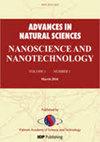角叉菜胶稳定葡萄柚精油纳米乳对HeLa细胞的自由基清除作用及其细胞毒性试验
IF 2.1
Q3 MATERIALS SCIENCE, MULTIDISCIPLINARY
Advances in Natural Sciences: Nanoscience and Nanotechnology
Pub Date : 2023-05-31
DOI:10.1088/2043-6262/acd6e5
引用次数: 0
摘要
葡萄柚皮精油由于其酚类和黄酮类化合物而具有抗氧化和抗菌活性。研究了柚子皮精油和卡拉胶的纳米乳液抗氧化性能。水包油(o/w)乳液由0.5%和1.0%(w/v)葡萄柚皮精油和卡拉胶配制而成。以卡拉胶为包封剂,降低挥发油的挥发性,提高挥发油的稳定性。使用透射电子显微镜(TEM)、紫外-可见光(UV–vis)分光光度法和傅里叶变换红外光谱(FTIR)对所得纳米乳液进行表征。与1.0%葡萄柚皮精油纳米乳液和游离葡萄柚相比,用0.5%葡萄柚皮香精油配制的纳米乳液表现出强烈的自由基清除2,2-二苯基-1-苦基肼(DPPH)效果,显示出最高的半最大有效浓度值(EC50),为83.4±1.4 mg l−1,总酚含量最高(80.1±11.8 mg GAE/g)果皮精油(2.0%w/v)。柚子皮精油制备的纳米乳液对HeLa细胞的细胞毒性也高于90%,不受纳米乳液配方的影响。柚子皮精油在纳米乳液中的掺入提高了其稳定性,同时保持了其生物活性和无毒性。本文章由计算机程序翻译,如有差异,请以英文原文为准。
Free radical scavenging effects of grapefruit essential oil nanoemulsion stabilized with carrageenan and its cytotoxicity assay on HeLa cell line
Grapefruit peel essential oil exhibited antioxidant and antibacterial activities attributed to their phenolic and flavonoid compounds. In this study, nanoemulsion of grapefruit peel essential oil and carrageenan was investigated for their antioxidant properties. The oil in water (o/w) emulsion was formulated with 0.5% and 1.0% (w/v) grapefruit peel essential oil and carrageenan. Carrageenan was utilised as an encapsulating agent to decrease volatility of essential oil and increase its stability. The resulting nanoemulsion was characterised using transmission electron microscopes (TEM), ultraviolet–visible (UV–vis) spectrophotometry and Fourier-transform infrared spectroscopy (FTIR). Nanoemulsion formulated with 0.5% grapefruit peel essential oil exhibited strong radical scavenging 2,2-diphenyl-1-picrylhydrazyl (DPPH) effects showing the highest half maximal effective concentration value (EC50) at 83.4 ± 1.4 mg l−1 and revealed the highest total phenolic content (80.1 ± 11.8 mg GAE/g) in comparison with 1.0% grapefruit peel essential oil-nanoemulsion and free grapefruit peel essential oil (2.0% w/v). The cytotoxicity of nanoemulsion prepared from grapefruit peel essential oil against HeLa cells also exhibited higher than 90% of cell viability, which was not affected by the formulation of nanoemulsion. The incorporation of grapefruit peel essential oil into nanoemulsion improved its stability while retaining its bioactivity and non-toxicity.
求助全文
通过发布文献求助,成功后即可免费获取论文全文。
去求助
来源期刊

Advances in Natural Sciences: Nanoscience and Nanotechnology
NANOSCIENCE & NANOTECHNOLOGYMATERIALS SCIE-MATERIALS SCIENCE, MULTIDISCIPLINARY
自引率
4.80%
发文量
0
 求助内容:
求助内容: 应助结果提醒方式:
应助结果提醒方式:


